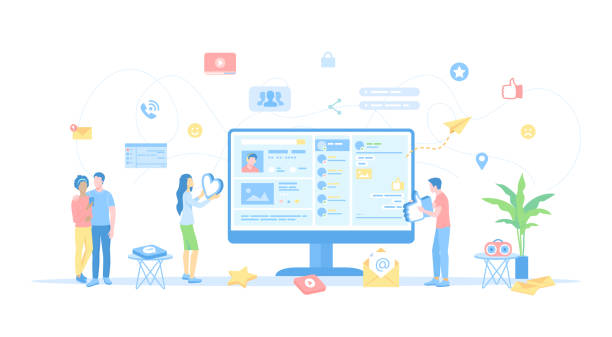Introduction to Modern UI Website Design and Its Importance
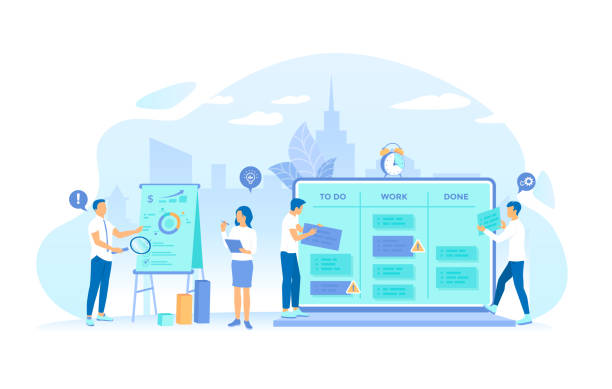
In today’s world, where the pace of technological change is high and users have ever-increasing expectations from their digital interactions, #website #design with a #modern #user #interface is no longer a competitive advantage, but an undeniable necessity.
This new approach in modern UI website design goes beyond mere aesthetics; its goal is to create a smooth, enjoyable, and efficient experience for the user, helping them easily achieve their goals on the website.
In this educational section, we will explore why this topic is important.
Websites have today become the main storefront for businesses and the first point of contact for many customers with your brand.
An old and inefficient user interface can immediately drive away potential customers, while a modern and user-friendly design can increase traffic, improve conversion rates, and strengthen customer loyalty.
This importance is vital for any business in attracting and retaining audiences.
This type of website design not only helps elevate the brand but also encourages users to spend more time on your site and engage more effectively.
The concept of User Experience (UX) and User Interface (UI) are inextricably linked in this approach, and a successful design is impossible without considering both.
This explanatory section will help you better understand why investing in this area is crucial.
Did you know that your customers’ first impression of your company is your website? With a powerful corporate website from Rasawb, multiply your business credibility!
✅ Custom and eye-catching design tailored to your brand
✅ Improved user experience and increased customer acquisition
⚡ Get a free consultation!
Fundamental Principles of Modern UI/UX
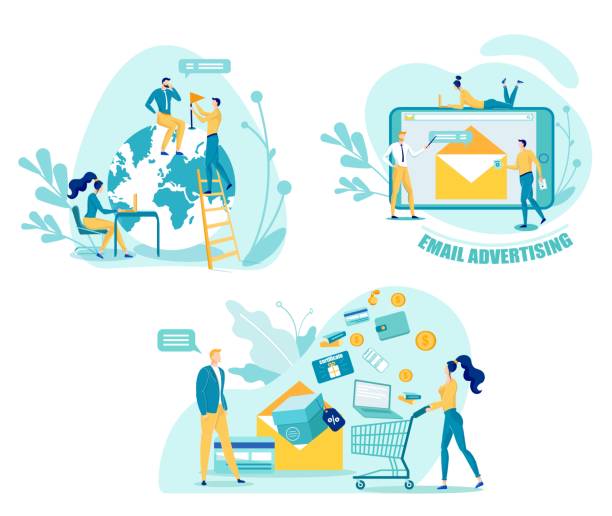
To achieve modern UI website design, one must be familiar with the fundamental principles of UI and UX.
These principles not only provide a framework for design but also ensure that the final product is both beautiful and functional.
The first principle is user-centricity; this means that all design decisions should be based on user needs and behaviors.
This includes conducting in-depth user research, building personas, and user journey mapping.
The second principle is simplicity and intuitiveness.
A modern user interface should be so simple that the user can easily interact with it and find their way without needing instructions or a guide.
This principle helps reduce the user’s cognitive load.
The third principle is consistency and integration; meaning that design elements, fonts, colors, and interactions should be uniform throughout the website to convey a sense of cohesion and professionalism.
This is especially important in advanced UI website design.
The fourth principle is feedback and clear communication.
Users should always be informed of the system’s current status; for example, they should receive visual or text feedback when submitting a form or loading a page.
This builds user trust.
Finally, accessibility is a vital principle; meaning the website should be usable for all users, including those with disabilities.
This is a specialized topic that requires technical knowledge and understanding of diverse user needs.
Adherence to these principles in every explanatory design project is key to success.
New Trends in Web UI Design
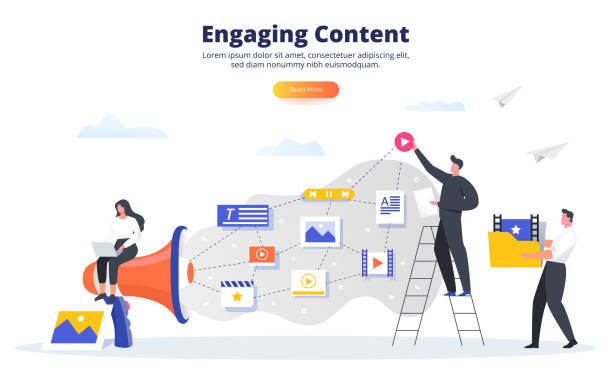
The world of modern UI website design is constantly evolving, and every year we witness the emergence of new trends that improve user experience and make websites more attractive.
Understanding these trends is crucial for every web designer and business owner to maintain an up-to-date and competitive online presence.
One of the most prominent trends is minimalism and clean design.
This approach emphasizes removing unnecessary elements and focusing on core content, leading to reduced distractions and improved readability.
Another trend is the widespread use of micro-interactions.
These small, subtle animations, such as a button changing color on click or an appealing loading icon, provide instant feedback to the user and make the experience more enjoyable.
Dark Mode also continues to maintain its popularity, as it is both easier on the eyes and saves battery life on devices with OLED screens.
The use of Artificial Intelligence (AI) and Machine Learning (ML) for personalizing user experience is also on the rise, allowing websites to adjust content and layout based on user behavior.
This is an important news development in the field of advanced UI design.
Additionally, 3D design and immersive graphics are making their way into the web, offering richer visual experiences.
Analyzing these trends is important for a future analytical outlook.
| Trend | Key Feature | Impact on User Experience |
|---|---|---|
| Minimalism | Focus on core content, ample white space | Increased readability, reduced distraction |
| Micro-interactions | Small animations and visual feedback | Increased enjoyment of use, user guidance |
| Dark Mode | Dark color theme for the user interface | Reduced eye strain, battery saving |
| AI in Personalization | Providing customized content based on user behavior | Increased engagement and user satisfaction |
| 3D Design | Graphics and elements with visual depth | Richer and more appealing visual experience |
The Role of User Experience (UX) in the Success of Modern UI Website Design

User Experience (UX) is the heart of every modern UI website design project.
While UI deals with the appearance and feel of a product, UX relates to how it functions and the feeling it gives the user.
A strong UX ensures that users can use the website easily, efficiently, and with complete satisfaction.
This section explains in detail the vital role of UX in the success of a modern website.
The first step in UX is user research.
Understanding user needs, goals, and pain points through interviews, surveys, and competitor analysis is essential for designing a meaningful experience.
Then, creating user personas helps designers better visualize their target audience.
User Journey mapping and site mapping are the next steps that outline the flow of user interaction with the website.
Wireframing and Prototyping are important tools that allow designers to test and validate their ideas before actual coding.
These steps are a very important guide for designing the site structure.
Poor UX can lead to high bounce rates, decreased conversion rates, and ultimately the failure of a website, even if it is visually appealing.
On the other hand, excellent UX makes users feel that their needs have been met, their goals achieved, and they have had a positive experience that encourages them to return and become loyal customers.
This is an analytical insight that demonstrates why UX plays a central role in designing websites with efficient user interfaces.
Are you tired of losing business opportunities due to not having a professional corporate website?
Rasawb, with its professional corporate website design, helps you:
✅ Build a powerful and reliable image for your brand
✅ Convert website visitors into loyal customers
⚡ Get a free consultation now!
Leading Tools and Technologies in Modern Website Design

Success in modern UI website design largely depends on using the right tools and technologies.
The web design tools market is constantly evolving, and knowing the most widely used and effective ones is essential for every web designer and developer.
In the field of UI Design, software like Figma, Sketch (for macOS), and Adobe XD have become industry standards.
These tools provide capabilities for wireframing, prototyping, and graphic design with unparalleled team collaboration.
Figma, in particular, has gained significant popularity due to its real-time collaborative features in the cloud.
This aspect of the work is completely specialized and requires specific skills.
In the front-end development section, JavaScript frameworks like React, Vue.js, and Angular play a pivotal role.
These frameworks enable the creation of interactive and complex user interfaces with high efficiency.
For content management and facilitating updates, Headless CMS systems such as Strapi or Contentful have gained popularity alongside front-end frameworks, providing greater flexibility for developers and significantly contributing to the formation of modern web design.
Furthermore, the use of animation libraries like GreenSock (GSAP) or Framer Motion is essential for creating micro-interactions and smooth animations.
These technologies collectively provide a powerful platform for creating websites with beautiful, fast, and user-friendly interfaces, and are important for anyone looking for guidance in choosing the right tools.
Challenges and Solutions in Modern UI Website Design

Despite all the advantages, modern UI website design also comes with challenges that designers and developers must be aware of and find appropriate solutions for.
One of the biggest challenges is the balance between aesthetics and performance.
Sometimes, too much focus on visual effects and complex animations can harm site performance and reduce loading speed.
The solution is to always prioritize Performance Optimization and use tools like Lighthouse to check site speed and efficiency.
Another challenge is compatibility with different browsers and devices.
Ensuring that the website displays correctly and performs consistently across all browsers (Chrome, Firefox, Safari, etc.) and devices (mobile, tablet, desktop) requires continuous and precise testing.
This aspect of the work is an explanation for the technical complexities.
Managing user expectations is also an important challenge.
Due to high competition, users are accustomed to fast, responsive, and visual websites.
Designing a user interface that meets and even exceeds these expectations requires a deep understanding of user psychology and current trends.
Solutions include iterative design, continuous user feedback collection, and using Agile approaches in development.
Also, security is a constant concern that must be incorporated from the outset in the process of designing websites with secure user interfaces.
Continuous team training and knowledge updates in this area are educational.
Content and Communication Strategy in Modern Website Design
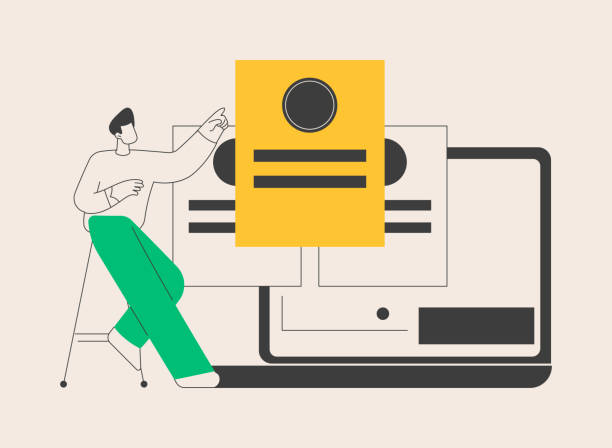
In the world of modern UI website design, content is not just “king” but the soul of the website.
A beautiful user interface without compelling and relevant content is like an empty shell.
Content strategy must be defined from the early stages of website design and integrated with UI/UX principles to deliver a rich and effective user experience.
This section discusses the importance of content and how to align it with advanced website design with excellent UI.
High-quality visual content, including images, videos, and infographics, plays a vital role in attracting the audience and conveying messages quickly and effectively.
Modern design emphasizes the use of white space and attractive visual layouts to highlight content.
Storytelling through content can establish a deeper connection with users and keep them engaged.
This is an entertaining aspect of design that can make a significant difference.
Additionally, interactive content such as surveys, quizzes, and online calculators makes users more active and helps collect valuable data for site improvement.
Content personalization based on user behavior and preferences is also highly important, with AI playing an increasing role in this area.
This aspect requires an analytical approach to understand user data and deliver relevant content.
Finally, the language and tone of the content must align with the brand and target audience to convey the message correctly and enhance the site’s credibility.
| Content Element | Importance in Modern Design | Examples |
|---|---|---|
| Visual Content | Quick audience attraction, efficient message delivery | High-quality images, short videos, infographics |
| Storytelling | Creating emotional connection, lasting memory | Narrative-driven “About Us” pages, interactive blog posts |
| Interactive Content | Increased user engagement, data collection | Surveys, quizzes, online calculators |
| Personalization | Providing relevant and customized experience | Product recommendations, dynamic content based on user history |
| Language and Tone | Conveying brand identity, building trust | Clear and friendly texts, engaging copywriting |
Optimization for Various Devices: Responsiveness in Website Design

One of the fundamental and vital pillars in modern UI website design is the concept of Responsiveness.
Given the countless variety of devices users employ to access the internet – from small mobile phones to tablets, laptops, and even smart TVs – it is essential for your website to provide an optimal user experience on every screen size.
This section delves into the importance and technical aspects of responsiveness.
Responsive design means that the website’s layout and content dynamically adapt to the user’s screen size.
This is typically achieved using Media Queries in CSS and grid-based or flexbox design.
The “Mobile-First” approach has become very popular in recent years.
In this approach, design begins first for the smallest screens (mobile) and then gradually expands to larger screens.
This method helps designers focus on essential content and functionality, preventing information overload in mobile versions, which is crucial for user-friendly UI website design.
Optimizing images, fonts, and interactive elements for touchscreens also is an important part of responsiveness.
For example, buttons and clickable elements must be large enough to be easily touched with a finger.
These aspects are essential to ensure website design with a seamless user experience across all devices.
Conducting continuous tests on various devices and browsers ensures that your website is always accessible and optimally performing.
This is an important educational section for every web developer.
Are you dissatisfied with the low conversion rate of visitors to customers on your e-commerce site?
With professional e-commerce website design by Rasawb, solve this problem forever!
✅ Increase visitor-to-customer conversion rate
✅ Create an excellent user experience and build customer trust
⚡ Get a free consultation!
Measuring Success and Continuous Improvement in Modern UI Website Design

After implementing a modern UI website design, the work is not over; rather, an important phase of analysis and continuous improvement begins.
The success of a website must be continuously measured to ensure that business and user goals are met.
This section discusses the tools and methods used to evaluate website performance and implement continuous improvements.
Web analytics tools such as Google Analytics provide valuable data on user behavior, including bounce rate, time spent on page, user navigation paths, and conversion rates.
Analyzing these metrics can reveal weaknesses in the user interface or content.
For example, a high bounce rate on a specific page might indicate confusing design or unappealing content.
A/B testing is a powerful method for comparing different versions of a design element (e.g., button color, heading, layout) and determining which version performs better.
These tests scientifically contribute to improving user experience.
Also, collecting direct feedback from users through surveys, interviews, or Usability Testing can provide deep insights into user problems and expectations.
Search Engine Optimization (SEO) is also an ongoing process that should be carried out in conjunction with UI/UX improvements.
This process provides guidance on how to iteratively and data-driven improve website design with optimized user experience.
The Future of Web Design and the Outlook of Modern User Interface

The world of modern UI website design is constantly moving, and predicting its future can be thought-provoking content, yet fascinating.
With the increasing pace of technological innovations, web user interfaces can be expected to undergo fundamental changes in the coming years.
One of the most important trends is the growing role of Artificial Intelligence (AI) in the design process.
AI-powered tools will be able to generate optimized designs, create prototypes, and even offer unprecedented personalizations based on user data.
This will significantly boost design speed and efficiency, leading to the creation of websites with intelligent user interfaces.
Voice User Interfaces (Voice UI) and Conversational User Interfaces (Conversational UI) are also gradually finding their place on the web.
With the growth of voice assistants and chatbots, users expect to interact with websites in more natural ways.
This paradigm shift creates new opportunities for innovative UI website design.
Additionally, the integration of Augmented Reality (AR) and Virtual Reality (VR) into the web experience can provide fully immersive and interactive environments, especially in areas like e-commerce and education.
This is an exciting news development that pushes the boundaries of design.
Ultimately, the focus on Immersive Experiences and seamlessness across all platforms, by eliminating friction and increasing user enjoyment, will shape the future of web design.
This outlook pushes designers towards greater creativity and thinking beyond traditional web pages.
Frequently Asked Questions
| Question | Answer |
|---|---|
| What is modern UI website design? | It is an approach to website design that focuses on clean aesthetics, simplicity, high usability, and providing a visually appealing and pleasant user experience (UX). |
| What are the key elements of a modern web UI? | Flat Design, intelligent use of white space, attractive typography, intuitive navigation, high-quality images, and responsiveness are key elements. |
| Why is using a modern UI important in website design? | It attracts and retains users, increases brand credibility, improves conversion rates, and provides a smooth and pleasant user experience. |
| How does modern User Interface (UI) affect User Experience (UX)? | Modern UI directly improves UX by creating a beautiful, organized, and understandable environment, making interaction easier. |
| What is the role of typography in modern UI design? | Typography is crucial for readability, establishing information hierarchy, conveying brand mood, and the overall visual appeal of the site. |
| How does Responsive design relate to modern UI? | Responsive design is an integral part of modern UI, as it ensures that the site’s appearance and functionality are consistent and optimal across all devices (mobile, tablet, desktop). |
| What are the current trends in modern web UI design? | Dark Mode, subtle animations, creative use of white space, bold typography, and the use of asymmetrical graphic elements are among the recent trends. |
| How can one ensure high Usability in modern UI design? | By conducting user testing, simplifying navigation, providing clear Calls-to-Action (CTAs), improving loading speed, and paying attention to Accessibility. |
| What is the main difference between UI and UX in the context of modern design? | UI is the look and feel of the site (user interface), while UX is the overall experience of the user when interacting with the site. UI is considered a part of UX. |
| What tools are used for modern web UI design? | Common tools such as Figma, Sketch, Adobe XD, Photoshop, and Illustrator are used for modern UI design and prototyping. |
And other services of Rasawb Advertising Agency in the field of advertising
Listing advertisements for hair wash chairs on commercial websites
Advertising facial tattoo tools on digital websites
Ads for hair trimmer devices on commercial platforms
Registering sellers of cosmetic loop lamps in online directories
Advertising wax warmer devices on commercial websites
And over a hundred other services in the field of internet advertising, advertising consultation, and organizational solutions
Internet Advertising | Advertising Strategy | Advertorials
🚀 Transform your business’s digital presence with Rasawb’s internet advertising strategies and advertorials.
📍 Tehran, Mirdamad Street, next to Bank Markazi, Southern Kazeroon Alley, Ramin Alley, No. 6

